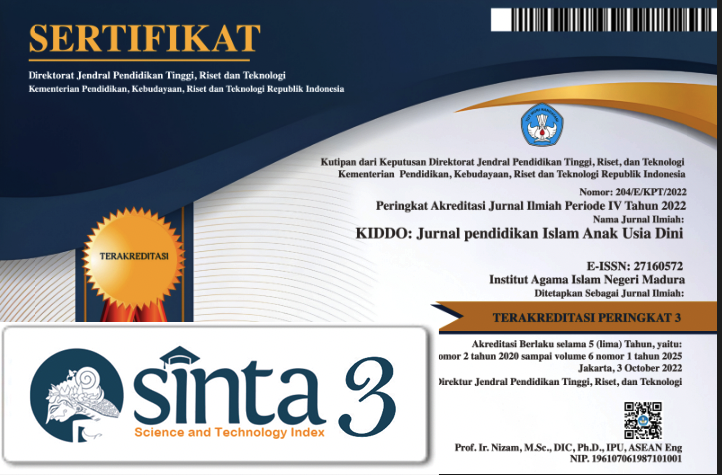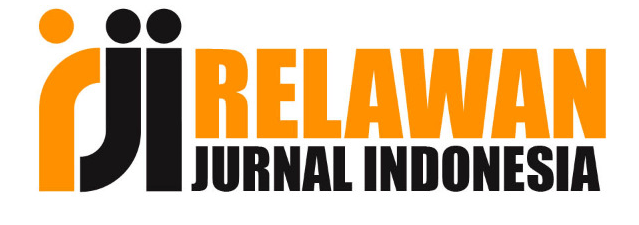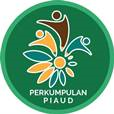Pengaruh Media Numerik Digital Terhadap Kemampuan Konsep Bilangan
 Abstract views: 370
,
Abstract views: 370
,
 PDF downloads: 315
PDF downloads: 315
Abstract
Practical learning media is often done using books, markers, magazines, and blackboards in introducing the concept of numbers. Even though early childhood requires sensorimotor activity that is symbolic in understanding new experiences and training children's concentration. The study aimed to determine differences in number concept abilities using digital numeric media in group B1 at Kindergarten Negeri 6 Bengkulu South. The total sampling of respondents in class B1 amounted to 10 with an age range of 5-6 years. The research method uses a quantitative approach with a pre-experimental research type using a one-group pretest - posttest research design. Data collection techniques using observation and tests. The data obtained were analyzed using the Independent Sample T-test. The results showed that Asymp.Sig (2-tailed) has a value of 0.000 <0.05, so H0 is rejected and Ha is accepted, meaning that there is an average difference between the pretest and posttest so that it can be concluded that the number concept ability of children aged 5-6 years is influenced by the media digital numeric.
Downloads
References
Arfinanti, N. (2018). Pengembangan Media Pembelajaran Matakuliah Metode Numerik dengan Implementasi Scilab Berbantuan Software Latex. Al-Khwarizmi: Jurnal Pendidikan Matematika Dan Ilmu Pengetahuan Alam, 6(2), 121–138. https://doi.org/10.24256/jpmipa.v6i2.370
Dantes, N. (2017). etode Penelitian. C. A. Offset, ed.
Dewa Made Adi Andhika Nida, P., Putu Parmiti, D., & Studi, P. (2020). Media Kartu Bergambar Berorientasi Pendidikan Karakter Pada Mata Pelajaran Bahasa Bali. Jurnal EDUTECH Universitas Pendidikan Ganesha, 8(1), 16–31. https://ejournal.undiksha.ac.id/index.php/JEU
Dihyah, M. (2021). Pengembangan Media Komik Strip Menggunakan Aplikasi Ibis Paint X Untuk Pembelajaran Akidah Akhlak.
Endang Kartikowati, Z. (n.d.). BUKU POLA PEMBELAJARAN SEMBILAN PILAR.
Farida, A., Wiwin, K., & Susanti, M. (2021). Capaian Pembelajaran Elemen Nilai Agama & Budi Pekerti (Vol. 1). https://buku.kemdikbud.go.id
Khaironi, M. (2017). PENDIDIKAN KARAKTER ANAK USIA DINI Mulianah. Golden Age Universitas Hamzanwadi, 01(2), 82–89.
Novitasari, Y., & Fauziddin, M. (n.d.). Perkembangan Kognitif Bidang Auditori pada Anak Usia Dini. Jurnal Obsesi : Jurnal Pendidikan Anak Usia Dini, 5(1), 805.
Palupi & Dewi. (2013). Pengaruh Media Flashcard Terhadap Kemampuan Mengenal Lambang Bilangan Pada Anak Kelompok B Di Tk Aba Iv Kota Kediri. 2(3). 2(3).
Pendidikan, K., Teknologi Badan Penelitian, D., Pengembangan, D., Perbukuan, D., Kurikulum, P., Melita, M., Sisilia, R., Buku, M., & Guru, P. (n.d.). Pengembangan Pengembangan Pembelajaran Pembelajaran Pengembangan Pembelajaran.
Purba, R. A., & D. (2020). Pengantar Media Pembelajaran. Yayasan Kita Menulis.
Putri, M. S., Reza, M., Widayanti, M. D., & Komalasari, D. (2022). Efektivitas Penggunaan Media Busy Book Dalam Meningkatkan Pengetahuan Mitigasi Bencana Banjir Pada Anak Usia 5-6 Tahun. KIDDO: Jurnal Pendidikan Islam Anak Usia Dini, 3(2), 66–77. https://doi.org/10.19105/kiddo.v3i2.6483
Riyana, C. (2012). Media Pembelajaran (2nd ed.). Direktorat Jenderal Pendidikan Islam Kementerian Agama RI.
Rohmalina, R., Aprianti, E., & Lestari, R. H. (2020). Pendekatan Open-Ended dalam Mempengaruhi Kemampuan Mengenal Konsep Bilangan Anak Usia Dini. Jurnal Obsesi : Jurnal Pendidikan Anak Usia Dini, 5(2), 1409–1418. https://doi.org/10.31004/obsesi.v5i2.805
Saifuddin Azwar. (2010). Metode Penelitian. In Pustaka Pelajar.
Sunu, B. P. (2019). Pengembangan Media Kartu Bergambar Berbasis Audio-Visual Pada Muatan Ips Di Kelas Iv Sd Negeri Sekaran 2. Jurnal Pendidikan Guru Sekolah Dasar. http://lib.unnes.ac.id/33398/1/1401414228_Optimized.pdf
Wulandari, Dantes, N., & Antara, P. A. (2020). Pendekatan Pendidikan Matematika Realistik Berbasis Open Ended Terhadap Kemampuan Pemecahan Masalah Matematika Siswa [Open Ended-Based Realistic Mathematics Education Approach to Students’ Mathematical Problem Solving Ability]. Jurnal Ilmiah Sekolah Dasar, 4(2), 131–142.
Copyright (c) 2023 melia eka daryati melia

This work is licensed under a Creative Commons Attribution 4.0 International License.
-
The journal operates an Open Access policy under a Creative Commons 4.0 International license. The terms of the license are:
Share— copy and redistribute the material in any medium or format
Adapt— remix, transform, and build upon the material for any purpose, even commercially.
1. Authors retain copyright and grant the journal right of first publication with the work simultaneously licensed under a Creative Commons License.that allows others to share the work with an acknowledgement of the work’s authorship and initial publication in this journal
2. Authors are permitted and encouraged to post their work online (e.g., in institutional repositories or on their website) prior to and during the submission process, as it can lead to productive exchanges, as well as earlier and greater citation of published work (See The Effect of Open Access).
Jurnal Kiddo is licensed under a Creative Commons
n Access).














